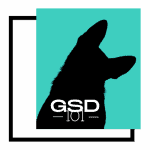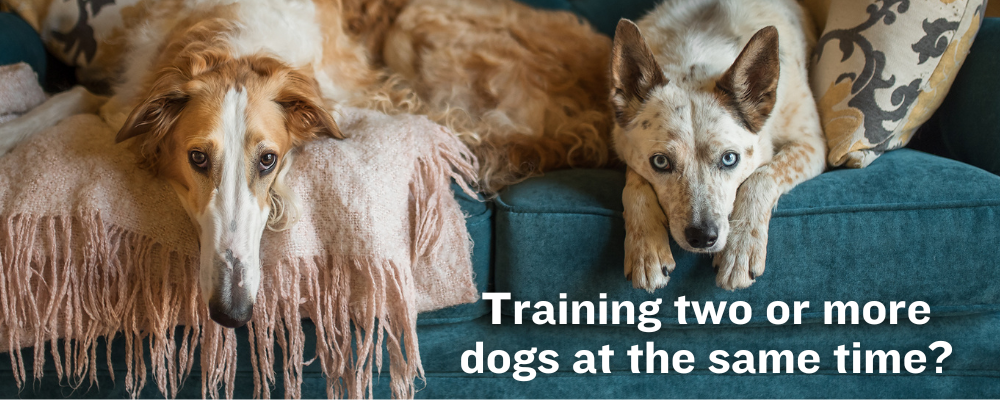German Shepherds definitely look wolfy, with their pricked ears and long nose, but if your GSD is howling at the moon, you may wonder, “is my German Sheperd part wolf?” Since the spike in popularity of wolf mixes after shows like Game of Thrones, it may be possible your GSD is a wolfdog.
If you don’t know your German Shepherd’s pedigree, and they show distinctive wolf-like traits, they may be part wolf. German Shepherd Wolf mixes are usually bigger, have longer legs, and show behavior like digging dens or skittishness. These wolfdogs are legal in some states and can enter the pet market, sometimes without new owners knowing.
So let’s go over why German Shepherds look so similar to wolves and can give the impression that they are part wolf. We also consult the experts so that you can check whether or not your GSD has wolf blood.
Is the German Shepherd mixed with the wolf?
Today’s German Shepherds are not wolves. While a few of the breed’s ancestors may have had some wolf blood, it was so long ago that your purebred GSD is now 100% dog. However, like all dogs, they are descended from the Gray Wolf and share 99.9% of their DNA with wolves.
Related: German Shepherd vs Wolf – What’s the Difference?
Why does the German Shepherd look like a wolf?
The German Shepherd has a distinctive wolf-like appearance. With a long nose and high-set pricked ears, they do share traits with wolves. There are three possible reasons for this.
GSDs simply trace back to dogs that look like wolves
When the breed founder, Max von Stephanitz, started breeding, he began with a dog Thuringian cross he renamed Horand von Grafrath. Thuringian dogs looked a lot like the Gray Wolf, as they had high, pricked ears, a thick gray coat, and a curled tail [Constructing The German Shepherd Dog}.
It’s said that Von Stephanitz preferred dogs that looked like wolves in his breeding program.
DNA tests show that these dogs were more closely related to the Gray Wolf than most breeds, although they are still dogs. So a significant reason that today’s German Shepherd has their distinctive Wolfy appearance is simply that their original forebears were just dogs that kept most of their wolfish appearance.
The first German Shepherds may have had some wolf blood
Horand von Grafrath certainly looked like a wolf, but Von Stephanitz clearly writes that he was descended from herding and guarding dogs in the area. Still, this has not quelled rumors that Horand possibly had a wolf ancestor.
Still, it does seem that dogs were bred to wolves in the early days. However, this did not work out well since these dogs had the typical wolfdog shyness. Shyness and nervousness are not good traits in dogs bred to be bold and courageous. So even if early German Shepherds were bred to wolves, these lines would likely have been bred out.
In the 1800s, some wolfdogs were used to create the perfect German Dog
Although Von Stephanitz disapproved of wolfdog crosses, he did mention them a few times. Before the German Shepherds became a registered breed, some breeders looking to breed the perfect German dog did cross some dogs to wolves.
So it certainly is possible that before German Shepherds became a breed, some wolves entered the bloodlines of the show dogs at the time. Studbooks in the 1800s had several dogs that seemed to be wolfdogs. But it is unclear if these dogs made it into the German Shepherd bloodlines, and we must remember that the term “wolf” is also the term for the color “sable.”
How to tell if your German Shepherd is part wolf?
Sometimes pet parents find themselves with German Shepherds that seem particularly wolfish. This is more common in states where wolfdog breeding is legal. (Source: Worldpopulationreview.com)
Sometimes, wolfdogs may be passed off in shelters or on Craiglist as German Shepherds. If you suspect this is the case, you can make sure through the following.
1. Perform a DNA Test
DNA test is one of most reliable ways to tell if your German Shepherd is part wolf. EmbarkVet has a reliable test you can do to check your dog’s ancestry and see if any wolf is lurking in the genetics.
If your German Shepherd really is a wolfdog, it’s good to know the percentage. High-content wolfdogs (dogs with a lot of wolf DNA) will have more wolf-like behaviors than low-content dogs.
2. Check the shape of your dog’s muzzle
Even though a German Shepherd’s muzzle is quite long, it is not shorter and thicker than a wolf’s. High-content wolfdogs will usually have abnormally long muzzles, all the better to eat you with!
The shape of the head is also a little different, with German Shepherds having a deeper dip from their forehead to their muzzle.
3. Consider their size versus a normal GSD
Not all wolfdogs are bigger than German Shepherds, but most are. The size of the wolfdog usually depends on the type of wolf, as some wolves are quite small. But the larger Gray Wolves can tip the scales around 145 pounds. Meanwhile, the largest male German Shepherds only make about 90 pounds.
To give you an idea of how much bigger a wolfdog can look next to a German Shepherd, just see this video:
4. Examine the color and shape of your dog’s ears
Both the German Shepherd and the wolf have erect ears positioned high on their heads. However, you may notice that a wolf’s ears are usually more rounded at the top, making a smaller triangle shape.
Another key difference is that the gray wolf typically has a dark rim around their ears, with white fur in the middle. They often pass this trait down to wolf mixes.
5. Examine the length and shape of your dog’s legs
Wolves have very long, narrow, and straight legs. They also have a straight back and a square shape. By comparison, German Shepherds have much shorter legs. German Shepherd’s hind legs are also extremely angulated, especially in show dogs. You will also see sloping or “roach” backs in GSDs that don’t exist in wolves
.
6. Was your dog born between March and May?
A German Shepherd can come into heat usually twice a year at any time. However, wolves only mate once a year between January and March, and their pups are born in March and May. So if you suspect your dog may have a wolf or a wolfdog for a mother, one clue may be their date of birth.
7. Does your dog bark?
Wolves don’t engage in many of the behaviors that German Shepherds do. For example, they are usually too skittish to be good guard dogs. And while they may howl, they usually do not bark.
Barking is canine behavior; you won’t see it as much in wolves, who may only bark to warn each other of a threat. Such as a mother wolf barking to tell her cubs there is a predator nearby. (Source: wolf.org)
8. Is your German Shepherd extremely shy and wary of strangers?
German Shepherds are bred to be bold, confident, and fearless. But this is simply not a trait that wolves have. In the wild, being cautious and nervous is essential for survival in a world with traps hunters, and bears. So wolves are naturally very timid and careful, except when hunting or challenging one another for dominance.
So if your German Shepherd seems unusually skittish around people and new environments, it may be a sign.
9. Does your GSD have any agouti coloring?
Agouti coloring is common in wolves, but you are not likely to see it in a purebred GSD. It means that each hair actually has two colors. The overall appearance is usually gray or brown, but you may notice ripples of darker or lighter pigment across the coat.
10. Does your female dog dig dens?
High-content wolf mixes don’t behave like dogs. They take longer to reach maturity, and they’re notoriously destructive to property. They also often escape artists who can travel many miles. But one thing you may notice in the females is that they dig dens. If you have a female German Shepherd that is part wolf, you can expect your yard to be dug up.
Just see the hole this wolfdog dug!
What is a German Shepherd Wolf mix?
A German Shepherd Wolf Hybrid is a cross between a German Shepherd dog and a Wolf. This is called a hybrid. People often get confused about what a hybrid really is. It’s common for “designer dogs” or mixed breed dogs like the Shepsky to be called a hybrid. But this is wrong.
A hybrid is a cross between two animals of different species. The two species must be genetically close enough to produce offspring. So examples of hybrids include the liger (a lion-tiger hybrid) or the coydog (coyote-dog mix). A German Shepherd wolfdog is a hybrid because it mixes two different canid species rather than two different dog breeds.
Are German Shepherd Wolf mixes good pets?
Generally, German Shepherd wolfdogs are not good pets. While a German Shepherd is one of the best family and working dogs in the world, when they are mixed with a wolf, the results are often tragic.
Let’s look at why GSD wolfdogs are not good pets:
1. GSD wolf mixes are the 6th breed most likely bite
Dog bite statistics show that wolfdogs have the 6th most dog bite fatalities by breed. (Source: Keller & Keller) This is significant because wolfdogs are still quite rare. The issue is that wolfdogs can never be fully socialized as a dog can. And their fearfulness makes them more prone to biting when they feel trapped and afraid.
They can also adopt hunting behaviors and become dangerous to animals and people in their area.
2. GSD wolf mixes can be destructive to property
Wolf hybrids are notoriously destructive to property. These dogs do everything from destroying furniture to wrecking doors to defecating and urinating even after potty training, to digging up the yard. People presented with a German Shepherd wolf hybrid often underestimate how much damage these creatures can do in a domestic environment.
They are also extremely loud when howling, which can bother your neigbors.
3. GSD wolf mixes can have severe behavioral problems
German Shepherd wolf crosses are often extremely active and difficult to raise as puppies. But this only gets worse as they get older. When wolf hybrids reach sexual maturity, they challenge their owners and other dogs for dominance in the pack. This makes them particularly dangerous.
One Reddit user writes, “This guy who lived down the street from me when I was growing up had two wolf/husky mixes that used to get out all the time and kill deer in our neighborhood. Eventually, they attacked a woman on the street and got shot by the police….”
4. GSD wolf mixes are prone to escaping
Because of their size, agility, and need to roam, wolfdogs are notoriously impossible to keep in a yard. They will pace their yard feverishly and scale impossible high walls, chew through wooden fencing, or dig underneath. This often leads to tragedy.
DanioMasher writes,” My GF was walking her two dogs (both relatively small breed dogs) today when they were attacked by a wolf-dog hybrid. The wolf dog had escaped from its owner’s yard, so it was not on a leash. She somehow managed to get the dog to stop attacking one of her dogs, by physically getting in between them, but then it just attacked her other dog.”
5. GSD wolf mixes are not good guard dogs (but will howl)
While wolfdogs love to howl to communicate, they aren’t good guard dogs. As typically shy and nervous creatures, they usually see no reason to bark or even attack an intruder. Instead, they tend to keep a distance. The instances of aggression above usually happen when they are hunting because of their prey drive.
They may also bite out of fear when they feel threatened or attack their owners to establish dominance. But they certainly do not operate as good guard dogs the way our beloved German Shepherds do.
6. GSD wolf mixes are usually the result of unscrupulous breeding practices
Breeding dogs is a tricky business, and we are all aware of the dangers of puppy mills and backyard breeders. However, wolfdog breeders are particularly controversial. Many argue that wolfdog breeding is particularly unethical, as these dogs often don’t make good pets and end up in shelters.
7. GSD wolf mixes are illegal in most states
Most states have banned the breeding of wolfdogs for ethical reasons. Some states, such as Alaska, Michigan, and North Dakota, protect wolfdogs as domestic pets. However, in twelve states, wolfdogs are illegal. This could mean that your wolfdog is euthanized or confiscated if found out.
Conclusion
In closing, we sincerely hope that your German Shepherd is not part wolf, but rather the purebred GSD that we all know and love. GSDs may look like wolves, but in terms of behavior, they have little in common. See this article if you want to know more about the differences between wolves and German Shepherds.



